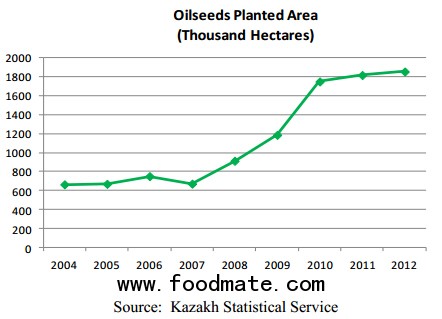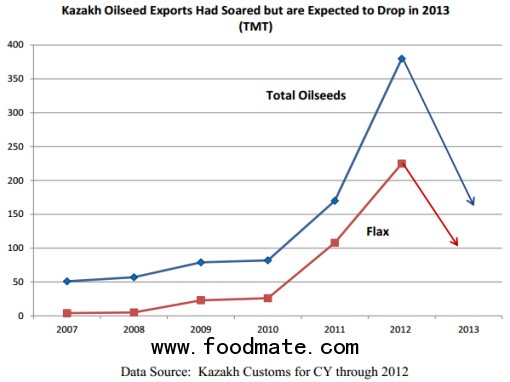This has caused planted area to soar, reaching a record 1.85 million hectares in 2012. Area for sunflowerseeds (the dominant oilseed) actually fell in 2012, while area for other oilseeds such as flax (for oil/linseed) and rapeseed continued to expand.

Despite increased area, oilseeds production in 2012 fell 14 per cent to 977,000 tons as a result of a severe drought in many northern growing regions. This decline was especially severe in flax and rapeseed, as production for these crops is concentrated in these drought-impacted Northern provinces.
Flax production was down 42 per cent from 2011, and rapeseed down 21 per cent. Sunflower production is located primarily in Eastern Kazakhstan (which was largely unaffected by the drought) and production fell only two per cent. Soybean production is located in Southern Kazakhstan, and production actually increased 28 per cent.
Trade
Although still relatively minor compared to grain exports, oilseed exports have seen very rapid growth in the past few years, increasing from just 50,000 metric tons 5 years ago to an estimated 380,000 metric tons in CY 2012. Flax exports have been one of the largest drivers for this growth, increasing from almost zero just 5 years ago to an estimated 230,000 metric tons in CY 2012.
The lion’s share (90% in CY 2012) of these exports is to the EU, especially Belgium. Rapeseed exports have also expanded, doubling in the past 5 years to an estimated 65,000 in CY 2012. These exports also are almost entirely destined for the EU. Small, yet significant exports of soybeans and sunflowerseeds also occurred in 2012.
In 2013, however, because of the smaller oilseed crops, exports are expected to drop sharply from last year’s record. This drop is expected to be especially severe in flax, as it was the most impacted by the drought in Northern Kazakhstan and has current stocks of only half last year’s level.

Stocks
With lower production, oilseed stocks have also fallen compared last year, from 677,000 tons on January 1, 2012, to 510,000 tons on January 1, 2013.
The decline in sunflowerseed stocks is much less than other oilseeds as the drought did not impact sunflower growing areas as severely. Sunflowerseed stocks fell only 10 per cent from the previous year, while rapeseed stocks down 17 per cent, flax down 54 per cent, and soybean stocks were actually up 15 per cent.
Reported oilseeds stocks on January 1, 2013 included: sunflowerseeds (46 per cent of the total), followed by
flax (19 per cent) and rapeseeds (15 per cent).





